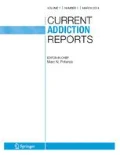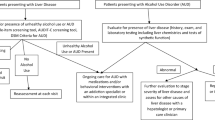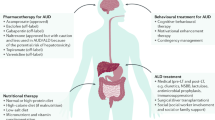Abstract
Purpose
Alcohol consumption is a leading cause of morbidity and mortality in our society and alcohol-related liver disease is a major contributor to this. Abstinence is the most important treatment goal for patients with alcohol-related liver disease and appropriate pharmacotherapy can help to achieve this.
Recent findings
There are a number of established and emerging pharmacotherapies for the treatment of alcohol use disorder that can be used in patients with liver disease although few have been studied extensively in this population. There are conflicting data on the effectiveness of these therapies and alcohol pharmacotherapy is an evolving field where more research is needed. The only effective treatment for alcoholic liver disease is abstinence.
Summary
High-quality comparative studies of pharmacotherapies and further inclusion of patients with comorbidity are needed. While current pharmacotherapies are of modest effect, many can be safely used in patients with alcoholic liver disease which is a major cause of morbidity and mortality where the only effective treatment is abstinence.
Similar content being viewed by others
References
Papers of particular interest, published recently, have been highlighted as: • Of importance
Hancock DB, Markunas CA, Bierut LJ, Johnson EO. Human genetics of addiction: new insights and future directions. Curr Psychiatry Rep. 2018;20:8.
Viken RJ, Kaprio J, Koskenvuo M, Rose RJ. Longitudinal analyses of the determinants of drinking and of drinking to intoxication in adolescent twins. Behav Genet. 1999;29:455–61.
Walker J, Bountress KE, Calhoun CD, Metzger IW, Adams Z, Amstadter A, et al. Impulsivity and comorbid PTSD-binge drinking. J Dual Diagn. 2018:1–20.
Sher KJ, Grekin ER, Williams NA. The development of alcohol use disorders. Annu Rev Clin Psychol. 2005;1:493–523.
Corral M, Holguin SR, Cadaveira F. Neuropsychological characteristics of young children from high-density alcoholism families: a three-year follow-up. J Stud Alcohol. 2003;64:195–9.
Tabakoff B, Hoffman PL. Alcohol addiction: an enigma among us. Neuron. 1996;16:909–12.
Gorky J, Schwaber J. The role of the gut-brain axis in alcohol use disorders. Prog Neuro-Psychopharmacol Biol Psychiatry. 2016;65:234–41.
Younossi ZM, Stepanova M, Afendy M, Fang Y, Younossi Y, Mir H, et al. Changes in the prevalence of the most common causes of chronic liver diseases in the United States from 1988 to 2008. Clin Gastroenterol Hepatol. 2011;9:524–530.e1.
Becker U, Deis A, Sørensen TI, Grønbaek M, Borch-Johnsen K, Müller CF, et al. Prediction of risk of liver disease by alcohol intake, sex, and age: a prospective population study. Hepatology. 1996;23(5):1025–9. https://doi.org/10.1002/hep.510230513.
Stickel F, Hampe J. Genetic determinants of alcoholic liver disease. Gut. 2012;61(1):150–9. https://doi.org/10.1136/gutjnl-2011-301239.
Raynard B, Balian A, Fallik D, Capron F, Bedossa P, Chaput JC, et al. Risk factors of fibrosis in alcohol-induced liver disease. Hepatology. 2002;35(3):635–8. https://doi.org/10.1053/jhep.2002.31782.
Anstee QM, Daly AK, Day CP. Genetics of alcoholic and nonalcoholic fatty liver disease. Semin Liver Dis. 2011;31(2):128–46. https://doi.org/10.1055/s-0031-1276643.
Fernandez-Checa JC, Kaplowitz N, Garcia-Ruiz C, Colell A. Mitochondrial glutathione: importance and transport. Semin Liver Dis. 1998;18(4):389–401.
Ambade A, Mandrekar P. Oxidative stress and inflammation: essential partners in alcoholic liver disease. Int J Hepatol. 2012;2012:853175. https://doi.org/10.1155/2012/853175.
Cao QBR. The role of T lymphocytes in the pathogenesis of ALD. Comprehensive handbook of alcohol-related pathology. London: Elsevier; 2005.
Hill DB, Deaciuc IV, Nanji AA, McClain CJ. Mechanisms of hepatic injury in alcoholic liver disease. Clin Liver Dis. 1998;3:703–21.
Thurman RGII. Alcoholic liver injury involves activation of Kupffer cells by endotoxin. Am J Phys. 1998;275(4 Pt 1):G605–11.
Parés A, Caballería J, Bruguera M, Torres M, Rodés J. Histological course of alcoholic hepatitis. Influence of abstinence, sex and extent of hepatic damage. J Hepatol. 1986;2(1):33–42.
Palmentieri B, de SI, La MV, Masarone M, Vecchione R, Bruno S, et al. The role of bright liver echo pattern on ultrasound B-mode examination in the diagnosis of liver steatosis. Dig Liver Dis. 2006;38:485–9.
Yu CH, Xu CF, Ye H, Li L, Li YM. Early mortality of alcoholic hepatitis: a review of data from placebo-controlled clinical trials. World J Gastroenterol. 2010;16(19):2435–9.
Mathurin P, Lucey MR. Management of alcoholic hepatitis. J Hepatol. 2012;56(Suppl 1):S39–45. https://doi.org/10.1016/S0168-8278(12)60005-1.
Sorbi D, Boynton J, Lindor KD. The ratio of aspartate aminotransferase to alanine aminotransferase: potential value in differentiating nonalcoholic steatohepatitis from alcoholic liver disease. Am J Gastroenterol. 1999;94:1018–22.
Day CP. Treatment of alcoholic liver disease. Liver Transpl. 2007;13(11 Suppl 2):S69–75. https://doi.org/10.1002/lt.21336.
• Lin ZH, Xin YN, Dong QJ, Wang Q, Jiang XJ, Zhan SH et al. Performance of the aspartate aminotransferase-to-platelet ratio index for the staging of hepatitis C-related fibrosis: an updated meta-analysis. Hepatology. 2011. Validated test to predict liver cirrhosis using only blood testing without imaging or invasive procedures, very high utility in alcohol use disorder population.
Nahon P, Kettaneh A, Tengher-Barna I, Ziol M, de LV, Douvin C, et al. Assessment of liver fibrosis using transient elastography in patients with alcoholic liver disease. J Hepatol. 2008;49:1062–8.
W.R K. OPTN/SRTR Annual Data Report 2014. In: Lake J.R. SJM, Skeans M.A, Schladt D.P, Edwards E.B, Harper A.M, Wainright J.L, Snyder J.J, Israni A.K, Kasiske B.L, editor.: American Journal of Transplantation; 2016. p. 69–98.
Rehm J, Samokhvalov AV, Shield KD. Global burden of alcoholic liver diseases. J Hepatol. 2013;59(1):160–8. https://doi.org/10.1016/j.jhep.2013.03.007.
Burra P, Senzolo M, Adam R, Delvart V, Karam V, Germani G, et al. Liver transplantation for alcoholic liver disease in Europe: a study from the ELTR (European Liver Transplant Registry). Am J Transplant. 2010;10(1):138–48. https://doi.org/10.1111/j.1600-6143.2009.02869.x.
Monto A, Patel K, Bostrom A, Pianko S, Pockros P, McHutchison JG, et al. Risks of a range of alcohol intake on hepatitis C-related fibrosis. Hepatology. 2004;39(3):826–34. https://doi.org/10.1002/hep.20127.
Grattagliano I, Ubaldi E, Bonfrate L, Portincasa P. Management of liver cirrhosis between primary care and specialists. World J Gastroenterol. 2011;17(18):2273–82. https://doi.org/10.3748/wjg.v17.i18.2273.
Tang-Barton P, Vas W, Weissman J, Salimi Z, Patel R, Morris L. Focal fatty liver lesions in alcoholic liver disease: a broadened spectrum of CT appearances. Gastrointest Radiol. 1985;10:133–7.
Alexander JF, Lischner MW, Galambos JT. Natural history of alcoholic hepatitis. II. The long-term prognosis. Am J Gastroenterol 1971.
Alvarez MA, Cirera I, Sola R, Bargallo A, Morillas RM, Planas R. Long-term clinical course of decompensated alcoholic cirrhosis: a prospective study of 165 patients. J Clin Gastroenterol. 2011;45:906–11.
Orrego H, Blake JE, Israel Y. Relationship between gamma-glutamyl transpeptidase and mean urinary alcohol levels in alcoholics while drinking and after alcohol withdrawal. Alcohol Clin Exp Res. 1985;9(1):10–3.
Mao YM, Zeng MD, Li YM, Wang BY, Shang J, Shi RH, et al. Capsule metadoxine in the treatment of alcoholic liver disease: a randomized, double-blind, placebo-controlled, multicenter study. Zhonghua Gan Zang Bing Za Zhi. 2009;17(3):213–6.
Caballería J, Parés A, Brú C, Mercader J, García Plaza A, Caballería L, et al. Metadoxine accelerates fatty liver recovery in alcoholic patients: results of a randomized double-blind, placebo-control trial. Spanish Group for the Study of Alcoholic Fatty Liver. J Hepatol. 1998;28(1):54–60.
Fede G, Germani G, Gluud C, Gurusamy KS, Burroughs AK. Propylthiouracil for alcoholic liver disease. Cochrane Database Syst Rev. 2011;6:CD002800. https://doi.org/10.1002/14651858.CD002800.pub3.
Rambaldi A, Gluud C. Colchicine for alcoholic and non-alcoholic liver fibrosis and cirrhosis. Cochrane Database Syst Rev. 2005;2:CD002148. https://doi.org/10.1002/14651858.CD002148.pub2.
Rambaldi A, Gluud C. Anabolic-androgenic steroids for alcoholic liver disease. Cochrane Database Syst Rev. 2006;4:CD003045. https://doi.org/10.1002/14651858.CD003045.pub2.
Ishii H, Kurose I, Kato S. Pathogenesis of alcoholic liver disease with particular emphasis on oxidative stress. J Gastroenterol Hepatol. 1997;12(9–10):S272–82.
Lieber CS, Weiss DG, Groszmann R, Paronetto F, Schenker S. II. Veterans Affairs Cooperative Study of polyenylphosphatidylcholine in alcoholic liver disease. Alcohol Clin Exp Res. 2003;27(11):1765–72. https://doi.org/10.1097/01.alc.0000093743.03049.80.
Klotz U, Avant GR, Hoyumpa A, Schenker S, Wilkinson GR. The effects of age and liver disease on the disposition and elimination of diazepam in adult man. J Clin Invest. 1975;55:347–59.
Leggio L, Lee MR. Treatment of alcohol use disorder in patients with alcoholic liver disease. Am J Med. 2017;130:124–34.
Nishimoto A, Usery J, Winton JC, Twilla J. High-dose parenteral thiamine in treatment of Wernicke’s encephalopathy: case series and review of the literature. In Vivo. 2017;31:121–4.
Wilson EC, Stanley G, Mirza Z. The long-term cost to the UK NHS and social services of different durations of IV thiamine (vitamin B1) for chronic alcohol misusers with symptoms of Wernicke’s encephalopathy presenting at the emergency department. Appl Health Econ Health Policy. 2016;14:205–15.
Hutcheon DA. Malnutrition-induced Wernicke’s encephalopathy following a water-only fasting diet. Nutr Clin Pract. 2015;30:92–9.
Hack JB, Hoffman RS. Thiamine before glucose to prevent Wernicke encephalopathy: examining the conventional wisdom. JAMA. 1998;279:583–4.
Moore KP, Aithal GP. Guidelines on the management of ascites in cirrhosis. Gut. 2006;55:vi1–vi12.
Zhao P, Zhao Y, Wei Z, Chen J, Yan L. Wernicke encephalopathy in a patient with liver failure: clinical case report. Medicine (Baltimore) 2016.
• Palpacuer C, Duprez R, Huneau A, Locher C, Boussageon R, Laviolle B et al. Pharmacologically controlled drinking in the treatment of alcohol dependence or alcohol use disorders: a systematic review with direct and network meta-analyses on nalmefene, naltrexone, acamprosate, baclofen and topiramate. Addiction. 2018. Large recent sytematic review and meta-analysis demonstrating paucity of evidence of efficacy for currently used alcohol pharmacotherapies. Suggests topiramate may have superior efficacy but more significant side effects compared to other available pharmacotherapies.
Kalk NJ, Lingford-Hughes AR. The clinical pharmacology of acamprosate. Br J Clin Pharmacol. 2014;77:315–23.
Rosner S, Hackl-Herrwerth A, Leucht S, Lehert P, Vecchi S, Soyka M. Acamprosate for alcohol dependence. Cochrane Database Syst Rev 2010.
Saivin S, Hulot T, Chabac S, Potgieter A, Durbin P, Houin G. Clinical pharmacokinetics of acamprosate. Clin Pharmacokinet. 1998;35:331–45.
Tolliver BK, Desantis SM, Brown DG, Prisciandaro JJ, Brady KT. A randomized, double-blind, placebo-controlled clinical trial of acamprosate in alcohol-dependent individuals with bipolar disorder: a preliminary report. Bipolar Disord. 2012;14:54–63.
Jonas DE, Amick HR, Feltner C, Bobashev G, Thomas K, Wines R, et al. Pharmacotherapy for adults with alcohol use disorders in outpatient settings: a systematic review and meta-analysis. JAMA. 2014;311:1889–900.
Anton RF. Naltrexone for the management of alcohol dependence. N Engl J Med. 2008;359:715–21.
Croop RS, Faulkner EB, Labriola DF. The safety profile of naltrexone in the treatment of alcoholism. Results from a multicenter usage study. The Naltrexone Usage Study Group. Arch Gen Psychiatry. 1997;54:1130–5.
Lindor KD, Gershwin ME, Poupon R, Kaplan M, Bergasa NV, Heathcote EJ. Primary biliary cirrhosis. Hepatology. 2009;50:291–308.
O'Malley SS, Krishnan-Sarin S, Farren C, O'Connor PG. Naltrexone-induced nausea in patients treated for alcohol dependence: clinical predictors and evidence for opioid-mediated effects. J Clin Psychopharmacol. 2000;20:69–76.
Garbutt JC, Kranzler HR, O'Malley SS, Gastfriend DR, Pettinati HM, Silverman BL, et al. Efficacy and tolerability of long-acting injectable naltrexone for alcohol dependence: a randomized controlled trial. JAMA. 2005;293:1617–25.
Kranzler HR, Wesson DR, Billot L. Naltrexone depot for treatment of alcohol dependence: a multicenter, randomized, placebo-controlled clinical trial. Alcohol Clin Exp Res. 2004;28:1051–9.
Mitchell MC, Memisoglu A, Silverman BL. Hepatic safety of injectable extended-release naltrexone in patients with chronic hepatitis C and HIV infection. J Stud Alcohol Drugs. 2012;73(6):991–7.
Mason BJ, Ritvo EC, Morgan RO, Salvato FR, Goldberg G, Welch B, et al. A double-blind, placebo-controlled pilot study to evaluate the efficacy and safety of oral nalmefene HCl for alcohol dependence. Alcohol Clin Exp Res. 1994;18:1162–7.
Palpacuer C, Laviolle B, Boussageon R, Reymann JM, Bellissant E, Naudet F. Risks and benefits of nalmefene in the treatment of adult alcohol dependence: a systematic literature review and meta-analysis of published and unpublished double-blind randomized controlled trials. PLoS Med. 2015;12:e1001924.
Skinner MD, Lahmek P, Pham H, Aubin HJ. Disulfiram efficacy in the treatment of alcohol dependence: a meta-analysis. PLoS One. 2014;9:e87366.
Mohanty SR, LaBrecque DR, Mitros FA, Layden TJ. Liver transplantation for disulfiram-induced fulminant hepatic failure. J Clin Gastroenterol. 2004;38:292–5.
Chick J. Safety issues concerning the use of disulfiram in treating alcohol dependence. Drug Saf. 1999;20:427–35.
Davidoff RA. Antispasticity drugs: mechanisms of action. Ann Neurol. 1985;17:107–16.
• Addolorato G, Leggio L, Ferrulli A, Cardone S, Vonghia L, Mirijello A et al. Effectiveness and safety of baclofen for maintenance of alcohol abstinence in alcohol-dependent patients with liver cirrhosis: randomised, double-blind controlled study. Lancet. 2007. Landmark clinic trial uniquely demonstrating safety of a pharmacotherapy for liver disease in patients with cirrhosis.
• Morley KC, Leung S, Baillie A, Haber PS. The efficacy and biobehavioural basis of baclofen in the treatment of alcoholic liver disease (BacALD): study protocol for a randomised controlled trial. Contemp Clin Trials. 2013. Clinical trial currently underway will further demonstrate safety and efficacy of baclofen in patients with alcoholic liver disease.
Morley KC, Baillie A, Leung S, Addolorato G, Leggio L, Haber PS. Baclofen for the treatment of alcohol dependence and possible role of comorbid anxiety. Alcohol Alcohol. 2014;49:654–60.
Santos C, Olmedo RE. Sedative-hypnotic drug withdrawal syndrome: recognition and treatment. Emerg Med Pract 2017.
Leung NY, Whyte IM, Isbister GK. Baclofen overdose: defining the spectrum of toxicity. Emerg Med Australas. 2006;18:77–82.
Reynaud M, Aubin HJ, Trinquet F, Zakine B, Dano C, Dematteis M, et al. A randomized, placebo-controlled study of high-dose baclofen in alcohol-dependent patients—the ALPADIR study. Alcohol Alcohol. 2017;52:439–46.
Addolorato G, Mirijello A, Leggio L, Ferrulli A, Landolfi R. Management of alcohol dependence in patients with liver disease. CNS Drugs 2013.
Johnson BA, Ait-Daoud N, Bowden CL, DiClemente CC, Roache JD, Lawson K, et al. Oral topiramate for treatment of alcohol dependence: a randomised controlled trial. Lancet. 2003;361:1677–85.
Langtry HD, Gillis JC, Davis R. Topiramate. A review of its pharmacodynamic and pharmacokinetic properties and clinical efficacy in the management of epilepsy. Drugs 1997.
Edwards S, Kenna GA, Swift RM, Leggio L. Current and promising pharmacotherapies, and novel research target areas in the treatment of alcohol dependence: a review. Curr Pharm Des 2011.
Mason BJ, Quello S, Shadan F. Gabapentin for the treatment of alcohol use disorder. Expert Opin Investig Drugs. 2018;27:113–24.
Bockbrader HN, Wesche D, Miller R, Chapel S, Janiczek N, Burger P. A comparison of the pharmacokinetics and pharmacodynamics of pregabalin and gabapentin. Clin Pharmacokinet. 2010;49:661–9.
Mersfelder TL, Nichols WH. Gabapentin: abuse, dependence, and withdrawal. Ann Pharmacother 2016.
Evoy KE, Morrison MD, Saklad SR. Abuse and misuse of pregabalin and gabapentin. Drugs. 2017;77:403–26.
Kilpatrick GJ, Hagan RM, Gale JD. 5-HT3 and 5-HT4 receptors in terminal regions of the mesolimbic system. Behav Brain Res 1996.
Johnson BA, Roache JD, Javors MA, DiClemente CC, Cloninger CR, Prihoda TJ, et al. Ondansetron for reduction of drinking among biologically predisposed alcoholic patients: a randomized controlled trial. JAMA. 2000;284:963–71.
Ait-Daoud N, Johnson BA, Prihoda TJ, Hargita ID. Combining ondansetron and naltrexone reduces craving among biologically predisposed alcoholics: preliminary clinical evidence. Psychopharmacology. 2001;154:23–7.
Figg WD, Dukes GE, Pritchard JF, Hermann DJ, Lesesne HR, Carson SW, et al. Pharmacokinetics of ondansetron in patients with hepatic insufficiency. J Clin Pharmacol. 1996;36:206–15.
Le AD, Corrigall WA, Harding JW, Juzytsch W, Li TK. Involvement of nicotinic receptors in alcohol self-administration. Alcohol Clin Exp Res. 2000;24:155–63.
• O'Malley SS, Zweben A, Fucito LM, Wu R, Piepmeier ME, Ockert DM et al. Effect of varenicline combined with medical management on alcohol use disorder with comorbid cigarette smoking: a randomized clinical trial. JAMA Psychiatry. 2018. Recent evidence for use of varenicline in patients with co-morbid cigarette smoking which is a very commonly encountered clinical situation.
Anton RF, O'Malley SS, Ciraulo DA, Cisler RA, Couper D, Donovan DM et al. Combined pharmacotherapies and behavioral interventions for alcohol dependence: the COMBINE study: a randomized controlled trial. JAMA 2006.
Kiefer F, Jahn H, Tarnaske T, Helwig H, Briken P, Holzbach R, et al. Comparing and combining naltrexone and acamprosate in relapse prevention of alcoholism: a double-blind, placebo-controlled study. Arch Gen Psychiatry. 2003;60:92–9.
Feeney GF, Connor JP, Young RM, Tucker J, McPherson A. Combined acamprosate and naltrexone, with cognitive behavioural therapy is superior to either medication alone for alcohol abstinence: a single centres’ experience with pharmacotherapy. Alcohol Alcohol. 2006;41:321–7.
Kiefer F, Wiedemann K. Combined therapy: what does acamprosate and naltrexone combination tell us? Alcohol Alcohol. 2004;39:542–7.
• Haber PS, Morley KC. The impact of alcohol pharmacotherapies on public health in Australia is limited by low prescribing rates. Public Health Res Pract. 2016. Recent retrospective data demontrating low levels of pharmacothearpy use and short duration of use in Australia.
Author information
Authors and Affiliations
Corresponding author
Ethics declarations
Conflict of Interest
The authors declare that they have no competing interests.
Human and Animal Rights and Informed Consent
This article does not contain any studies with human or animal subjects performed by any of the authors.
Additional information
This article is part of the Topical Collection on Alcohol
Rights and permissions
About this article
Cite this article
Stoklosa, T.M., Morley, K.C., Volovets, A. et al. Pharmacotherapy for Alcohol Use Disorder in the Context of Liver Disease. Curr Addict Rep 5, 287–296 (2018). https://doi.org/10.1007/s40429-018-0211-1
Published:
Issue Date:
DOI: https://doi.org/10.1007/s40429-018-0211-1




